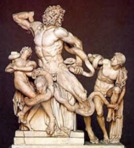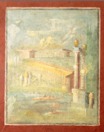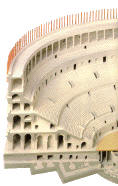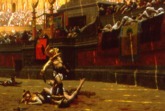

In Roman mythology, the city was founded by two brothers, who had been raised by a wolf. Romulus and Remus.
Making generalizations about the visual culture of any group of people is a crude endeavor, especially with a culture as diverse as Rome's. With this thought in mind, know that this survey, as any must be, is tremendously limited in its breadth and depth.
Examples of Roman art:

Laocoön
and his Sons, Roman copy
of a Hellenistic original
from c. 200 BCE,
marble, height
1.84 m, Vatican. Trojan priest Laocoön and his two sons
are attacked at an altar
by giant serpents. Pliny said it was the work of three sculptors
from Rhodes, Hagesandros, Polydoros, and Athenodoros. The date
of the Laocoön is controversial, some scholars arguing for
the late second century BCE,
others for c. 50 BCE.
See pain.

Rome, Bust of Sextus Pompeius, 30s BCE,
bronze, height
39 cm, State Hermitage Museum, St. Petersburg, Russia.

Rome, Cubiculum (bedroom) from the Villa of P. Fannius
Synistor, c. 40-30 BCE,
Republican, Second Style, fresco;
room: 8 feet 8 1/2 inches x 10 feet 11 1/2 inches x 19 feet 7
1/8 inches (265.4 x 334 x 583.9 cm), Metropolitan Museum of Art,
NY.

Roman, Augustus of Primaporta, early 1st century
CE
after a bronze of the
1st century BCE,
marble.

Roman, Pont du Gard Aqueduct, near Nimes, France,
c. 20-10 BCE.
See aqueduct and arch.

Rome, Statue of the Emperor Octavian Augustus,
first quarter of the 1st century CE,
height 185 cm, State Hermitage
Museum, St. Petersburg, Russia. The emperor is represented here
as Jupiter, the supreme God of the Roman pantheon, and this statue
is a typical example of Roman sculpture from the time of the
Empire. The composition was adapted from the celebrated sculpture
of Zeus by Phidias, which allowed the placing of the appropriate
attributes in Augustus's
hands: a Nike and a sceptre.
The sculptor preserved the emperor's portrait features, but idealized
them to create a formal cult statue.
![]()
Roman, Asia Minor, Head of Caligula Worked for Insertion into Togatus
Statue, about 40 CE,
marble, 16
15/16 inches (43 cm), J. Paul Getty Museum, Malibu, CA. The Roman
emperor Gaius, more commonly known by his nickname Caligula,
ruled from A.D. 37 to 41 and was extremely unpopular. In fact,
after he was murdered, almost all portraits of him were destroyed.

Roman, Landscape, c. 40 CE,
fresco "end
of Third Style", scene: 66.2-66.6 x 52.3-52.8 cm, white
border: 2-7 mm, red wall: 7.7-15.5 cm, George Ortiz collection.
Allegedly from Stabiae. The Third Style is also called the "ornate" and the "ornamental" style of
Roman fresco painting. See landscape and tratteggio.

Roman, Rome, Colosseum (Flavian Amphitheater), 70-82
CE.
A vast ellipse in plan, length
620 feet x width 513 feet
(188 x 156 m), with
 eighty external arcaded
openings on each storey, those on the ground floor forming entrances
from which the various tiers
of seats were reached.
eighty external arcaded
openings on each storey, those on the ground floor forming entrances
from which the various tiers
of seats were reached. See a cutaway view. The upper storey was added
222-224, around the top of which were sockets for 240 wooden
masts which carried a massive canopy (velarium). The façade's
entire height is 157 feet
6 inches (48.5 m). Each of the four storeys are pierced by arches, and have attached
three-quarter columns
and entablatures, Doric in the first story,
Ionic in the second,
Corinthian in the third,
and above these are pilasters
of Corinthian design, with small square window openings in alternate
bays. The wooden floor of the arena is an oval
287 x 180 feet, surrounded by a wall 15 feet high, behind which
were the podium, with the imperial throne, and seats for the
pontifex maximus, vestal virgins, senators, praetors, and other
officers of the state. Behind the podium rose the auditorium
seats for some 50,000-75,000 spectators, with corridors and stairs
beneath, while dens for wild beasts were under the lowest tier,
on a level with the arena. The seats (now removed) were in four
main horizontal divisions.
The construction of this amphitheater
is notable for its combination of materials,
carefully chosen for the purposes to which they were applied.
The design of this structure was made possibly because of the
Romans' invention of concrete,
used primarily for the foundations. Different types of concrete
were utilized depending on their need to be especially solid,
or to be reduced in weight.
Travertine was used to
face the exterior, for the piers
and arcades, tufa infill between piers for the walls of the lower
two levels, brick-faced concrete for the upper levels and for
most of the vaults, limestone
largely for floors, and marble
for seats, columns, and ornament.
Even in its current
ruined state, the Colosseum recalls the gladiatorial contests,
the naval displays, and the martyrdom of Christians which took
place within its walls before it became a medieval
fortress or was plundered to provide building materials for Renaissance
palaces and churches. Another view of the Colosseum.

Jean-Léon Gérôme (French,
1824-1904), Pollice Verso (Thumbs Down), 1872, oil on canvas,
39.5 x 58.625 inches, Phoenix Art Museum. Gérôme
studied the architecture
of the Colosseum, along with other historical evidence in producing
this history
painting. To the right of the imperial throne, the vestal
virgins indicate their desire for the death of a defeated combatant.
Light streaming between sections
of canopy streaks across the floor and lower walls. Ridley Scott
(American, contemporary) has said that this picture inspired
his production of the movie Gladiator in 2000, starring
Russell Crowe and Joaquin Phoenix.
![]()
Roman, after the School of Polykleitos, Statue of the Lansdowne Herakles (Hercules),
about 125 CE,
marble, height 76 3/16 inches (193.5
cm), J. Paul Getty Museum, Malibu, CA.
Egyptian (Hawara, Roman period, Funerary Portrait of a Young Girl, second century CE), encaustic on wood, height 15 3/4 inches, Cleveland Museum of Art.
Roman, Denarius, Septimius Severus (Emperor 193-211 CE),
silver;
obverse: In the center
is a bust in profile of Emperor Septimius Severus. He
wears a laurel wreath. His hair is curly, his beard ending in
pin-curls. The text: "SEVERVS . . . PIVSAVG" -- Severus
Pius Augustus -- his name and the titles bestowed on him as emperor.
reverse: In the center is Roma, the goddess of the city of Rome.
In her left arm, she holds a spear. A shield stands beside her,
leaning against her seat. The text is probably: "NOB . .
VRBIS" -- noblissimus urbis meaning noblest city. Michael
Delahunt Collection.

Rome, Bust of Emperor Philip the Arab, c. mid-3rd
century CE,
marble, height 72.3 cm, State Hermitage
Museum, St. Petersburg, Russia. See bust.
Giovanni Battista Piranesi (Italian, 1720-1778), The Colosseum, 1761, etching, from Le vedute di Roma, Michael C. Carlos Museum, Emory U, Atlanta, GA.
See articles on various media (such as architecture, bronze, ceramics, glass, and marble, mosaic, sculpture, and vessel), and form (such as sarcophagus). Also see Apollo, archaeology, colossus and colossal, Etruscan art, forum, Greek art, incrustation, mythology, Neoclassicism, Renaissance, Romanesque, Romanitas, UNESCO Convention on the Means of Prohibiting and Preventing the Illicit Import, Export and Transfer of Ownership of Cultural Property, UNIDROIT Convention on Stolen or Illegally Exported Cultural Objects, and Vandals.
https://inform.quest/_art